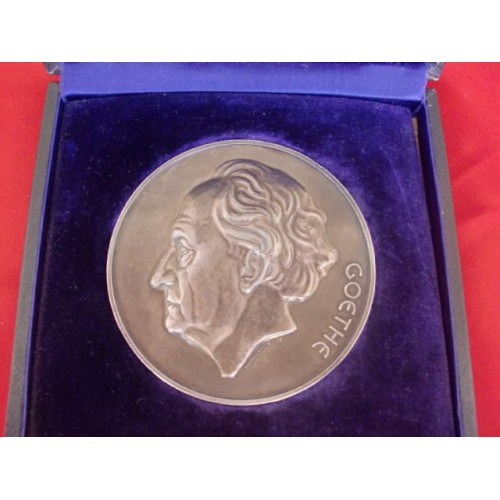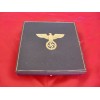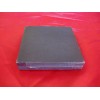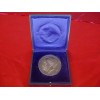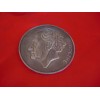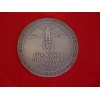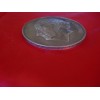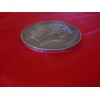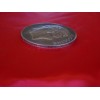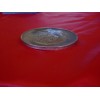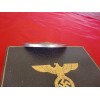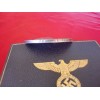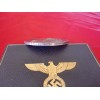Cased Goethe Medal for the Arts and Science # 2546
Cased Goethe Medal for the Arts and Science # 2546
This is considered the most prestigious and rare of all German awards. The "Goethe Medaille für Kunst und Wissenschaft" was founded in 1932 to reward outstanding service during the Goethe centennial. It was initially intended to be a one-time award, but President Hindenburg retained it as a national award and this practice was continued by Hitler. The medallion is in genuine silver measuring 2 3/4 inches in diameter and has the profile of Goethe on the obverse and the name "Goethe on the right. On the reverse is the stylized national eagle over the inscription "Für Kunst und Wissenschaft" or ("For Art and Science"). Engraved around the outer edge is the inscription that translates to: "Founded by Reich President von Hindenburg 1932. The Berlin sculptor Hanisch-Concee was responsible for the design of the medallion and his signature is found immediately under the neck of Goethe. The earlier-produced medals like this one have the recipient's name engraved in large, block letters around the edge. The proof mark on the edge is "835 PR ST. MB". This stands for the 835 silver designation and the Prussian State Mint. The Goethe Medal continued to be awarded even after the introduction of the German National Prize for Art and Science in 1937. As of January 1943, a total of 467 had been awarded. The medallion is contained in a blue, simulated-leather hinged case with blue-velvet base interior. On the top of the cases lid is an absolutely gorgeous national eagle heavily embossed in gold on the pebbled-finish case. The recipient was "Prof. Franz Fischer" as engraved along the edge. These medals were invariably personally presented by Adolf Hitler, himself, at a very grandiose ceremony and it certainly was the most respected civil award of the Reich next to the Eagle Shield of Germany and the National Prize for the Arts and Sciences, which was a replacement for the Nobel Prize since he had forbidden German citizens to accept the international prize.
Franz Fischer (1877-1947), was a German chemist who, along with Hans Tropsch, invented in 1923 a revolutionary new process for converting solid fuels to liquid fuels. Fisher's work, spanning several decades, was key in fulfilling the German's plan to always keep a plentiful supply of petroleum. Fischer and others invented and developed two processes that enabled them to synthesize petroleum from their country's abundant coal supplies, and to establish the world's first technologically successful synthetic liquid fuel industry. By the end of World War II, nine Fischer-Tropsch (F-T) plants were in operation in Germany, supplying significant amounts of fuel for the German war effort. Refinements to the Fischer-Tropsch process have improved its efficiency, although its commercial success hinges on a plentiful supply of cheap coal and the price of the synthetic fuel relative to conventional oil.
German Militaria
(Cased Goethe Medal for the Arts and Science)


